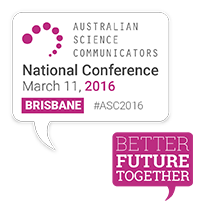A/Prof Jen Martin, ASC national Vice President
At the end of September I had the great pleasure of attending the PCST Venice Symposium Science communication education and training: Challenges and strategies for research and academic institutions. Venice is a long way to go for a three-day symposium but having never come across an event before focused exactly on what my team does (teaching communication skills to scientists in an academic institution), my strong suspicion was that it would be worth making the effort to attend. And that definitely turned out to be the case. It was an absolute joy to spend three days with roughly 100 people from around the world who are deeply passionate about science communication education and training.
The symposium
took place at Venice International University which is located on San Servolo
island, about 10 minutes by boat (vaparetto) from Saint Mark’s Square in Venice.
The island is tiny and very beautiful and used to be an asylum. These days it
has a restaurant, café, lots of accommodation for students and other university
visitors and a variety of teaching and meeting spaces. It also has some
beautiful gardens and one of my favourite things was seeing people arrive each
morning on the early vaparetto to walk their dogs in the gardens – presumably
because there’s so little green space in Venice itself.
The first day of the symposium included a number of
keynote presentations and roundtables including discussions about what research
and academic institutions are doing to support researchers’ science
communication and how these institutions can integrate science communication
research and evaluation insights into practice and training. Day one finished
with a visit to the glorious San Zaccaria church in Venice and a fascinating
session on ‘The Art of Conversation and
Conversation in Art’.
On the next day we broke into
four working groups, each focused on a different aspect of the broader topic:
1:
Supporting researchers’ public communication;
2:
Recruiting science communication professionals and developing their
competencies;
3:
Evaluating and improving the quality of research communication;
4:
Using science communication research results in institutional activities.
Each working group spent part of their time hearing presentations from members of the group and part of the time in discussion with the goal of coming up with key recommendations on their topic. I was thrilled to have the opportunity to share my story of founding the science communication teaching program at the University of Melbourne including what my team does and some of the things we’ve learned along the way about how to establish and grow such a program. We also heard from many other people involved with amazing training programs and it was interesting (and more than a little sad) to discover just how common and widespread an experience it is for science communication education, training and research to be undervalued and insufficiently supported in universities and research institutions around the world.
On the last day each group presented their
recommendations, and we had a fantastic whole-group discussion about our
conclusions and what useful steps we could take to improve science
communication education and training. The result is a statement to leaders of
academic and research institutions worldwide which highlights the need for research and academic
institutions to consider the strategic value of the public communication of
science, and to mobilise support for these activities. The statement is going
to be useful for anyone seeking institutional or local support for science
communication and I’ll share with our ASC membership when it’s published.
Aside from the
stunning location, of course the best thing about any conference is the people
you meet and PCST Venice was no exception. In addition to catching up with some
other wonderful Australian scicomm people (Jenni, Toss and Tullio), I met so
many other scicomm educators, practitioners and researchers from around the
world, many of whom I’ll definitely stay in contact with. Science communication
education is a small field and I feel incredibly grateful to have had the
opportunity to connect with so many others who do work I think is exceptionally
important and valuable.


